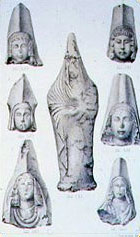Contestani



Contestani (Ancient Greek (Κοντεστανοί) is an ethnonym of Roman Spain of the imperial period. It appears chiefly in the Greco-Roman writers Pliny the Elder (Natural History (Pliny) iii.iii.19-20), 1st century, and Claudius Ptolemy (The Geography ii.5 on Hispania Tarraconensis), 2nd century. Pliny might be considered the more creditable, as he was for a time procurator of the official Hispania Tarraconensis, a province of the Roman Empire encompassing all the north and all the east of the Iberian Peninsula (the chief part of the future nation of Spain).[1]
A geographic ethnonym from ancient times, however, was not necessarily the name of a people. It might be a toponym. Perhaps the name of the supposed people came from the name of the place. In that case, anyone could live in the place and be counted as one of its people without the necessity to belong to an ingroup such as a tribe. L. A. Curchin did an etymological study of all the ancient names in Contestani and Edetani to the north of it. The implied distribution was multilingual and therefore multiethnic: 14% Iberian, 3% Punic, 35% Indo-European, the rest uncertain.
Location[edit]
They lived in a region located in the southwest of Hispania Tarraconensis, east of the territory of the Bastetani, between the city of Urci, located NE of the Baetica and river Sucro, today known as Júcar. Nowadays this would correspond to a section of the Albacete Province, the eastern part of the Region of Murcia and the southern part of the Valencian Community.[2]
Cartago Nova was within its territory. Other important towns were Setabi (Xàtiva), Lucenti or Lucentum (La Albufereta in Alicante), Alonis (Villajoyosa), Ilici (Elche), Menlaria, Valentia and Iaspis. Iberian coins were minted at Setabi.[3] Important Contestani archaeological sites include Tolmo de Minateda hill near Hellín and Bastida de les Alcusses, near Mogente.[4]
See also[edit]
- Iberians
- Pre-Roman peoples of the Iberian Peninsula
- Lucentum
- Lady of Elche
- Treasure of Villena
- Tolmo de Minateda
- La Bastida de les Alcusses
References[edit]
- ^ Smith, Philip (1854). "Contestani". In Smith, William (ed.). Dictionary of Greek and Roman Geography. Perseus Digital Library.
- ^ Lorenzo Abad Casal, La Contestania Ibérica, treinta años después, Universidad de Alicante. Servicio de Publicaciones, 2005. ISBN 84-7908-845-1
- ^ José Uroz Sáez, Economía y sociedad de Contestania ibérica, Instituto de estudios alicantinos,1998. ISBN 84-00-04959-4
- ^ Abad Casal L, Gutiérrez Lloret S, Sanz Gamo R. El Tolmo de Minateda. Una historia de tres mil quinientos años. Junta de Comunidades de Castilla La Mancha, Toledo, 1999
Bibliography[edit]
- Ángel Montenegro et alii, Historia de España 2 - colonizaciones y formación de los pueblos prerromanos (1200-218 a.C), Editorial Gredos, Madrid (1989) ISBN 84-249-1386-8
